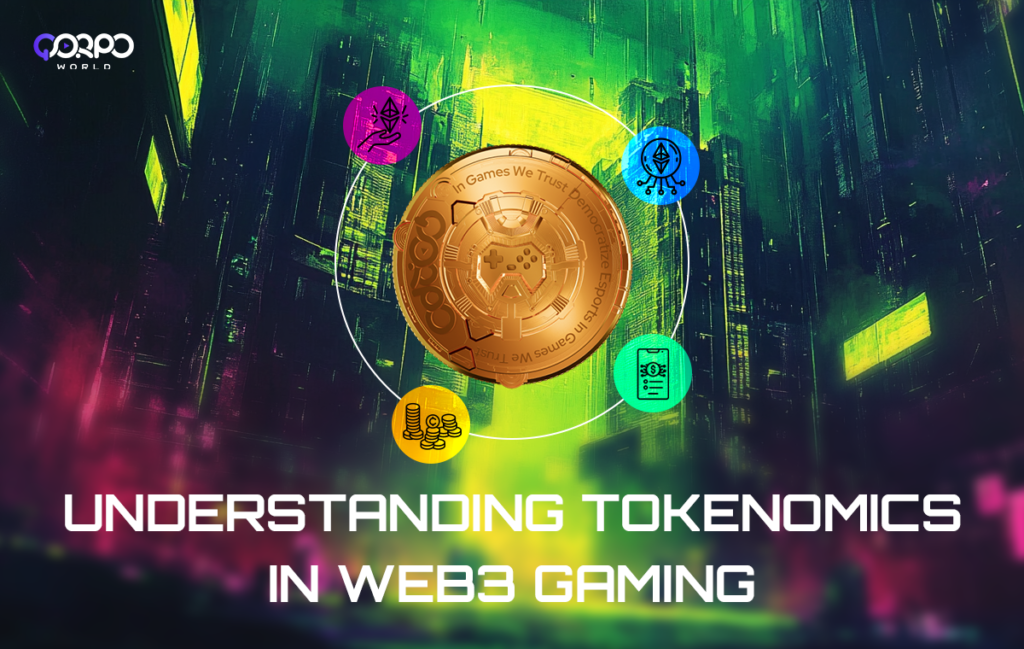
Have you ever played any game in the GTA series? You might have spent countless hours leveling up your character and exploring the gameplay. Yet, you know that any money spent on a pack is locked within that game.
You have no way to extract value or to get an ROI because, when it comes down to it, that nice car you bought in GTA is not yours; it’s more like it’s leased to you by GTA. This is the reality of traditional gaming economies, which you know already.
So what does any of this have to do with understanding tokenomics in Web3 gaming? Well, with Web3 gaming, tokenomics design changes the paradigm you’re used to in traditional games. Gamers like you can earn real rewards and also own the assets they bought.
Tokenomics, a portmanteau of token and economics, refers to the design and implementation of economic systems within blockchain-based platforms. Think of it like the game economies you have played in, only that this time, you own your assets, which have value.
Web3 gaming introduces a new layer of value—tokens—that ensures game economies function seamlessly. As the co-founder of Animoca Brands, Yat Siu emphasized:
“Tokens offer a novel means for people to own a piece of any network effect.”
And he’s correct; Web3 gaming ecosystems typically employ one of two token models:
- Single Token Model: QORPO World uses this approach, where one token serves more products within the ecosystem.
- Dual Token Model: Axie Infinity adopts this system, utilizing two separate tokens for different purposes.
Regardless of the model, Web3 gaming offers a unique advantage. If you’re new to gaming or have played Fortnite, Valorant, or GTA, this article explores all you need to know about gaming tokenomics.
Token Types and Utilities
In Web3 gaming, understanding the different types of tokens is crucial for gamers. Tokenomics typically involves three primary categories: utility tokens, governance tokens, and NFTs. Each serves a distinct purpose, influencing gameplay, governance, and asset ownership.
- Utility Tokens: These are the backbone of in-game economies, used for transactions like buying items and breeding characters. For example, the $SLP token in Axie Infinity acts as a utility token for breeding and interacting with the ecosystem.
- Governance Tokens: These allow players to vote on key decisions within the game. Axie Infinity’s governance token, AXS, empowers players to influence the future development of the game.
- Non-Fungible Tokens (NFTs): NFTs in games like Citizen Conflict or RavenQuest represent unique in-game assets such as characters, weapons, or land. Players truly own these items and can trade or sell them across platforms.
As you already know, traditional games do not offer true ownership of in-game assets. Items and currencies are typically locked within the game’s ecosystem.
While games like Fortnite allow players to purchase skins or battle passes, these remain confined to the game’s environment. For example, in Diablo Immortal, reaching the highest level with maximum gear could cost players around USD 100,000.
Despite this massive investment, players face some challenges if they want to recover or trade this value. Their options are either selling the account directly to a trusted friend or risking transactions through third-party websites and community channels where scams are common.
In contrast, with the token systems in Web3 games, there’s a solution with in-game transactions, where players can mint their entire account (or specific valuable assets) and sell them securely through established marketplaces, providing true ownership and verifiable transactions.
Economic Models In Tokenomics
Understanding economic models is also vital; it affects your experience and the game’s viability. The economic models in Web3 gaming differ significantly from traditional games because most of them offer more intricate and sustainable ecosystems.
One of the primary differences is in the use of tokens, which helps stabilize the economy by separating governance from in-game currency.
Single vs. Dual-Token Models:
Not all Web3 games use a dual-token system. For instance, while Axie Infinity uses AXS for governance and SLP for in-game activities, QORPO World uses a single token across all its gaming titles. But the economics of the token is what matters; what can you do with it?
What do you need it for? How can you get the token in the game? What is the supply? How much is vested, and what is the vesting plan? These are what make the Web3 gaming economy work.
Utility and Sink Mechanisms:
These mechanisms regulate token supply within a game. Utility introduces tokens into the economy (e.g., earning tokens through gameplay). While sinks remove them (e.g., burning tokens during upgrades or purchases).
QORPO World for example employs these mechanisms to control inflation and ensure economic stability.
Incentives and Reward Systems:
Web3 games often include play-to-earn (P2E) mechanics where players can earn real-world value through their in-game activities. In Axie Infinity, players earn tokens by battling and breeding Axies, which can then be exchanged for rewards.
This is in stark contrast to traditional models like Fortnite, where purchases do not result in any rewards. Web3 economic models are designed to also reward players, unlike traditional games that limit player involvement to only entertainment.
The co-founder of Yield Guild Games, Gabby Dizon, puts this even more succinctly on the Beacon Podcast:
“The matching of community with a great product, enabling community ownership with tokens and NFTs with tokenomics—I think it’s still the best way to get millions of people into web3 games and web3 in general.”
Truly, this is why the design of tokens is way more important than just the number of allocations they come with.
Why Designing Sustainable Tokenomics is Important
Designing sustainable tokenomics is crucial for the long-term success of any Web3 game. A well-balanced token economy ensures that players are rewarded without destabilizing the game’s financial structure.
A good case study here would be Axie Infinity, where an imbalance between player rewards and economic sustainability led to inflation, which caused a significant drop in daily active users. Inflation control is critical in Web3 games. Introducing too many tokens into the game without appropriate sinks—you remember what they are, yeah?—this inflation can devalue rewards. This can lead to dissatisfaction among players.
This is why mechanisms like Utility and sinks are essential, regulating the flow of tokens to maintain their value. Moreover, token distribution must prevent wealth accumulation and ensure that new players can still take part in it.
A good case study would be QORPO World; the token distribution model prevents wealth accumulation while ensuring that new players can also play. This is achieved through several key mechanisms:
- Ecosystem Integration: The QORPO token is seamlessly integrated across all QORPO gaming titles. This enhances utility and scalability as the ecosystem grows. The broad integration ensures that the token’s value is not concentrated in a single game or application.
- Inclusive Staking Opportunities: QORPO offers diverse stake options for a wide range of participants, including players, investors, and NFT holders, with varied entry points and rewards.
- Player Incentives: A part of the tokens is for distribution among players, platform users, and NFT and token holders. This is tied to ecosystem revenue and engagement metrics.
- Governance Rights: Token holders gain governance rights, allowing them to influence key ecosystem decisions through direct votes on the QORPO WORLD. This democratic approach prevents centralized control and gives the community a voice in the platform’s development.
- Buy-Back and Burn Mechanism: A dedicated buy-back and burn mechanism uses ecosystem revenue to purchase and remove $QORPO tokens from circulation. When players mint in-game assets as NFTs, they pay in $QORPO, with a portion of each transaction being burned. This creates a deflationary effect—the more players mint assets, the more $QORPO is burned.
Did you notice how QORPO World Token has many use cases across their gaming titles? This also creates a direct link between Web2 player growth and $QORPO’s deflationary mechanics.
As the player base expands, more assets are minted to Web3, driving increased $QORPO usage and burning—strengthening the token’s value proposition. This approach prevents the concentration of wealth amongst certain players and ensures that the ecosystem functions.
Web3 Game Tokenomics is not a Buzzword.
One key takeaway from this article is that tokenomics is not a buzzword; it plays a major role in every gamer’s gaming experience.
Token value will become important with cross-game economies popping up. This is because it further expands the utility of these tokens. So as Web3 games get published, you can now learn more about their tokenomics models. And at the same time, enjoy more exciting gameplay experiences.

